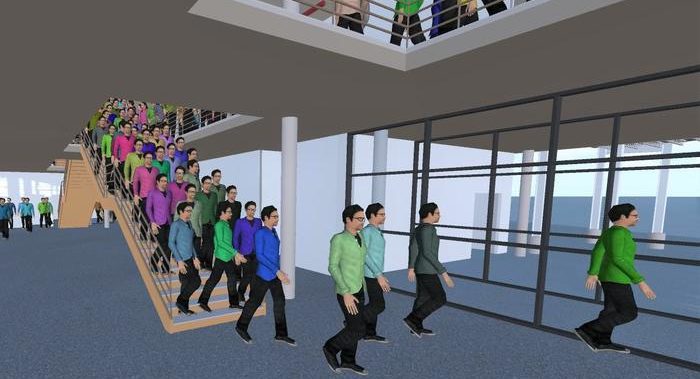Expert opinion on escape routes
The workplace regulation ASR A2.3 specifies the dimensions of escape routes and is currently being updated by the Committee for Workplaces (ASTA). As part of this revision, accu:rate GmbH and IST GmbH prepared an expert opinion: Two independent microscopic simulation models were used to investigate the extent to which constrictions and stairs on escape routes, as well as staggered use of escape routes, influence the escape time.

Description
Client: Committee for Workplaces (ASTA)
Task: Consideration of escape times in connection with constrictions and stairs on escape routes, as well as staggered use of escape routes
Result: Escape times of several escape route widths investigated
Background
Task: Consideration of escape times in connection with constrictions and stairs on escape routes, as well as staggered use of escape routes
Result: Escape times of several escape route widths investigated
Background
Background
To ensure the safety and health of employees when setting up and operating workplaces, the employer must take precautions to ensure that employees can get to safety immediately and be rescued quickly in the event of danger. A key factor here is the design of escape routes and emergency exits. In Germany, their number, arrangement and dimensions are regulated by the Technical Rule for Workplaces ASR A2.3, which is published by the Federal Ministry of Labor and Social Affairs. Some of the requirements contained therein originate from earlier guidelines. The Committee for Workplaces (ASTA) is therefore reviewing and updating ASR A2.3.
Objective of the simulation
In this context, accu:rate GmbH was commissioned together with IST GmbH to prepare an expert report on escape routes in workplaces - the influence of route width, stairs, doors and constrictions on evacuation. The aim of this report was to make a statement about the factors influencing escape routes that affect evacuation times. Two independent microscopic simulation models were used to investigate the extent to which constrictions and stairs on escape routes and the staggered use of escape routes influence the evacuation time. Macroscopic model calculations were carried out for comparison, and previous studies and data were compiled.
Our approach
You can find a detailed description of the procedure here: ASR A2.3: Rethinking escape routes
Results
The results show that a short constriction on horizontal paths has hardly any effect on the clearance time. However, longer constrictions, such as those caused by office furniture, have a significant impact on evacuation times. Vertical escape route elements (stairs) also have a significant influence on evacuation times, as they have a flow-reducing effect. Constrictions such as doors in front of stairs are therefore negligible as long as they are within the permissible range. It was also found that a time-delayed alarm has a positive effect on the evacuation of the affected levels. Further investigations are required to define the required escape route width and to set it in relation to the number of people per level. Finally, the largely linear correlation between the number of people and the escape route width was also confirmed in this report. However, this has not yet been mapped in ASR A2.3 point 5 para. 3. Here, there is a jump from an escape route width of 1.00 m for up to 20 people to an escape route width of 1.20 m for up to 200 people.

School building acts as a reference project
A school building was considered as an additional scenario in order to investigate the influence of the width of classroom doors on the escape time. For this purpose, a school building was used that complies with the regulations of the Model School Building Guideline (MSchulbauR). The simulations clearly show that the width of the classroom doors in the 0.90 m and 1.20 m variants has no significant influence on the school's evacuation time; instead, the width of the stairs represents the dominant capacity bottleneck.
Do you have a similar project or would you like more information?
We look forward to hearing from you!